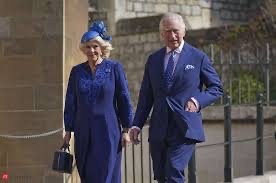According to royal commentator Richard Fitzwilliams, King Charles is facing a significant “problem” concerning Prince William’s children, namely Prince George, Princess Charlotte, and Prince Louis. Fitzwilliams suggests that the official portraits of the royal family released after King Charles’ coronation highlight the aging nature of the monarchy, which King Charles will need to address.
The release of official portraits following significant royal events, such as a coronation, is a customary practice that showcases the current royal family and signifies a new era for the monarchy. These portraits often capture the present generation of royals and provide a glimpse into the future of the institution. In the case of King Charles, the portraits would include his son Prince William and his grandchildren, representing the next line of succession.
Fitzwilliams raises concerns about the portrayal of the royal family in these official portraits, suggesting that they emphasize the aging nature of the monarchy. As King Charles assumes the throne, he will need to navigate the challenges of presenting a fresh and contemporary image of the royal family while respecting its longstanding traditions and heritage.
Prince George, Princess Charlotte, and Prince Louis, as members of the younger generation, symbolize the future of the monarchy. Their inclusion in official portraits is essential to showcase continuity and the forthcoming reign. However, Fitzwilliams suggests that King Charles will face the task of finding a balance between portraying the royal family as a modern institution and addressing any perception of the monarchy as outdated or disconnected.
The portrayal of the royal family in official portraits is a reflection of the changing times and expectations. As younger generations seek relatability and relevance, the monarchy must adapt and evolve to maintain its relevance and public support. King Charles, as the future monarch, will play a crucial role in shaping the monarchy’s image during his reign.
While the concerns raised by Fitzwilliams highlight the need for careful consideration, it is important to remember that official portraits are just one aspect of the monarchy’s public representation. The royal family’s engagement with charitable work, public appearances, and modern communication channels also contribute significantly to how they are perceived by the public.
Furthermore, King Charles will have a team of advisors and experts who will assist him in addressing the challenges and opportunities that lie ahead. Their expertise in public relations, image management, and understanding public sentiment will be invaluable in navigating the delicate balance between tradition and modernity.
As King Charles prepares to ascend the throne, there will likely be a renewed focus on ensuring the monarchy remains relevant and appealing to a broad spectrum of society. This may involve initiatives aimed at connecting with younger generations, leveraging digital platforms to engage with the public, and championing causes that resonate with contemporary issues.
The future of the monarchy lies in its ability to adapt and evolve while upholding its core values and traditions. King Charles, as the future monarch, will have the opportunity to shape the institution and guide it into a new era. By embracing change, fostering a sense of inclusivity, and effectively communicating the monarchy’s relevance, King Charles can navigate the “problem” identified by Fitzwilliams and ensure a prosperous future for the British monarchy.


